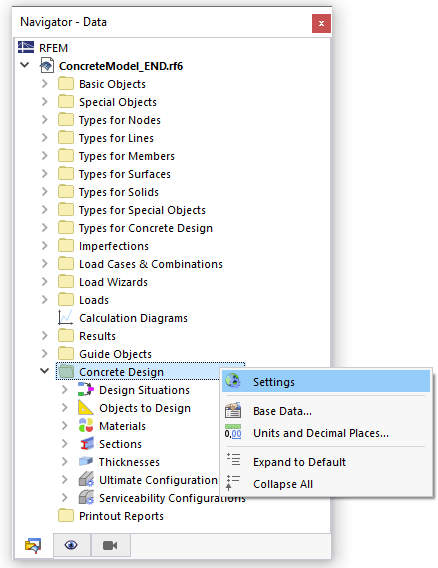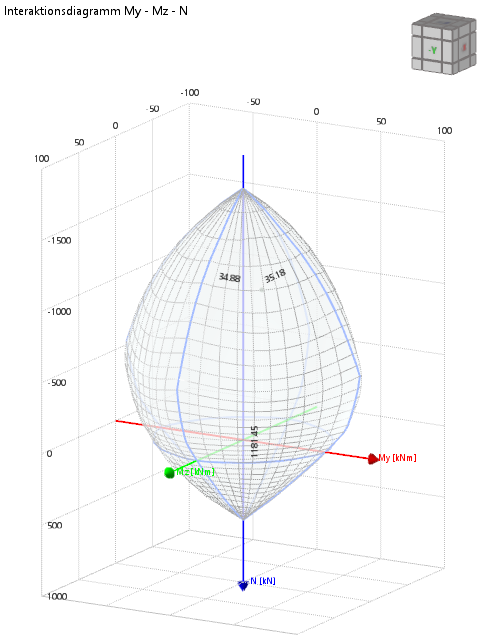General specifications of the concrete design are stored in the Global Settings dialog box. You can open this dialog box by clicking the
![]() button in the toolbar of the tables for the "Concrete Design" category (see the image
Design Situations
). As an alternative, you can use the shortcut menu of the "Concrete Design" entry in Navigator.
button in the toolbar of the tables for the "Concrete Design" category (see the image
Design Situations
). As an alternative, you can use the shortcut menu of the "Concrete Design" entry in Navigator.
The global settings are independent of the
Standard
, however, the individual standard values may differ. You can also use the
![]() button to restore the default settings of the design standard.
button to restore the default settings of the design standard.
Configurations to Calculate
Use the check boxes to specify which design configurations should be analyzed generally. For design according to EN 1992‑1‑1, the "Ultimate" and "Serviceability" configurations are activated by default.
Analysis Method
The "Enumeration Method" is set for both members and surfaces by default. The "Envelope Method" and the "Mixed Method" are available as further design methods.
- Enumeration Method: All load combinations in a design situation are calculated individually, one by one. This usually leads to the most accurate results, but may also lead to increased calculation time.
- Envelope Method: The enveloping internal forces are calculated first, which result from the extreme values for the design situations. The envelope is then used for the design. This usually leads to a shorter calculation time, but in certain circumstances, it may lead to an inefficient design compared to the Enumeration Method.
- Mixed Method: Both methods described above are combined here. There is the option to adjust "number of variants" as a limit value, where you can switch between the Enumeration Method and the Envelope Method. With the default value of 20, the program uses the Enumeration Method as long as the number of "result variants" is less than 20. If the number of variants in a design situation is greater than or equal to 20, the Envelope Method is used to save calculation time. You can make the settings separately for members and surfaces.
Optimization – Maximum Allowable Design Ratio
The design concept is based on a design procedure. This means that you specify a cross-section and a reinforcement, and the program carries out the design checks with these specifications. In the future development of RFEM and RSTAB, the optimization of cross-sections and reinforcement specifications is also planned. A specific design criterion or a percentage of utilization is sought for for the individual design checks. You can also specify a value deviating from "1.00", which may be smaller or larger, in order to influence the optimization goal.
Storing Results
You can specify whether to save the results for the individual x-locations of a member ("By location") or for the member as a whole only ("By object"). The latter takes less time, but makes a detailed evaluation in the result tables more difficult.
For surfaces, you can specify whether to save the results for each FE mesh node or grid point and each design ("By location"), or whether to save only the result of the governing point in the surface for each design ("By object").
Calculate Results
This option controls whether the locations of the FE mesh nodes or the grid points should be used for the design of the surfaces (see the chapter Results by Surface of the RFEM manual).
This setting affects the results that are displayed in the Concrete Design result tables and in the design details. This has no influence on the graphic results.
Life Cycle of Results
The Concrete Design results are deleted as soon as you change the input data. This ensures that the design is based on the correct boundary conditions. In some cases, however, it can be useful to keep the results, for example, if you want to adjust the existing reinforcement and still see the results of the previous calculation – the uncovered reinforcement. In this case, deactivate the check box to avoid the complete recalculation of the concrete results.
Interaction Diagram
Here, you can specify the parameters that should be used for the result display of the design details as an interaction diagram.




